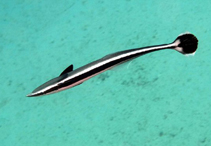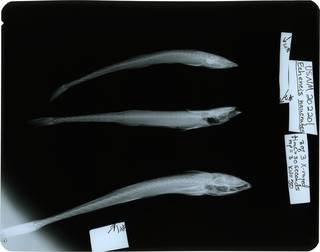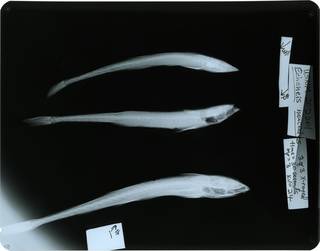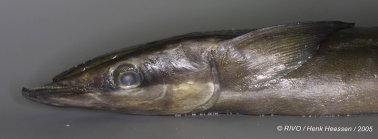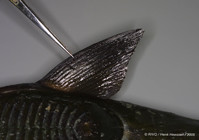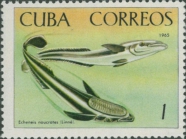
| Introduction | | Search taxa | | Taxon tree | | Taxon match | | Checklist | | Literature | | Stats | | Photogallery | | OBIS Vocab | | Log in |
WoRMS taxon detailsEcheneis naucrates Linnaeus, 1758
126848 (urn:lsid:marinespecies.org:taxname:126848)
accepted
Species
Echeneis chiromacer Duméril, 1858 · unaccepted
Echeneis fasciata Gronow, 1854 · unaccepted
Echeneis fusca Gronow, 1854 · unaccepted
Echeneis guaican Poey, 1860 · unaccepted
Echeneis lunata Bancroft, 1831 · unaccepted
Echeneis metallica Poey, 1860 · unaccepted
Echeneis naucratus Linnaeus, 1758 · unaccepted (misspelling)
Echeneis neucrates Linnaeus, 1758 · unaccepted (misspelling)
Echeneis scaphecrates Duméril, 1858 · unaccepted
Echeneis vittata Rüppell, 1838 · unaccepted
Echensis naucrates Linnaeus, 1758 · unaccepted (misspelling)
Echneis naucrates Linnaeus, 1758 · unaccepted (misspelling)
Leptecheneis flaviventris Seale, 1906 · unaccepted
Leptecheneis naucrates (Linnaeus, 1758) · unaccepted
marine, brackish,
Linnaeus, C. (1758). Systema Naturae per regna tria naturae, secundum classes, ordines, genera, species, cum characteribus, differentiis, synonymis, locis. [The system of nature through the three kingdoms of nature, according to classes, orders, genera, species, with characters, differences, synonyms, places.]. <em>Impensis Direct. Laurentii Salvii. Holmiae [Stockholm].</em> 1(10) [iii], 824 p., available online at https://biodiversitylibrary.org/page/726886 [details] Available for editors
Description Often found free-swimming in shallow inshore waters. Attaches temporarily to a variety of hosts including sharks, rays,...
Description Often found free-swimming in shallow inshore waters. Attaches temporarily to a variety of hosts including sharks, rays, large bony fishes or sea turtles, whales, dolphins and also to ships. Sometimes used by natives to aid in fishing: a line is tied to the caudal peduncle of the remora and then is released; upon attaching to another fish, the remora and its host are hauled in by the fisherman (Ref. 9682). [details] Distribution circumtropical; Western Atlantic: Nova Scotia, Canada and Bermuda to Uruguay
Distribution circumtropical; Western Atlantic: Nova Scotia, Canada and Bermuda to Uruguay [details]
Froese, R. and D. Pauly. Editors. (2025). FishBase. Echeneis naucrates Linnaeus, 1758. Accessed through: World Register of Marine Species at: https://www.marinespecies.org/aphia.php?p=taxdetails&id=126848 on 2025-07-15
Date action by
Nomenclatureoriginal description
Linnaeus, C. (1758). Systema Naturae per regna tria naturae, secundum classes, ordines, genera, species, cum characteribus, differentiis, synonymis, locis. [The system of nature through the three kingdoms of nature, according to classes, orders, genera, species, with characters, differences, synonyms, places.]. <em>Impensis Direct. Laurentii Salvii. Holmiae [Stockholm].</em> 1(10) [iii], 824 p., available online at https://biodiversitylibrary.org/page/726886 [details] Available for editors original description (of Echeneis lunata Bancroft, 1831) Bancroft, E. N. (1831). Specimens were exhibited of several fishes, lately received from Dr. Bancroft of Kingston, Jamaica, Corr. Memb. Z. S. <em>Proceedings of the Committee of Science and Correspondence of the Zoological Society of London.</em> 1830-31 (pt 1): 134-135. [details] original description (of Leptecheneis flaviventris Seale, 1906) Seale, A. (1906). Fishes of the South Pacific. <em>Occasional Papers of the Bernice P. Bishop Museum.</em> 4(1): 1-89, pl. 1., available online at https://biodiversitylibrary.org/page/7122973 [details] basis of record van der Land, J.; Costello, M.J.; Zavodnik, D.; Santos, R.S.; Porteiro, F.M.; Bailly, N.; Eschmeyer, W.N.; Froese, R. (2001). Pisces, <B><I>in</I></B>: Costello, M.J. <i>et al.</i> (Ed.) (2001). <i>European register of marine species: a check-list of the marine species in Europe and a bibliography of guides to their identification. Collection Patrimoines Naturels,</i> 50: pp. 357-374 (look up in IMIS) [details] Ecologyecology source
Looby, A.; Erbe, C.; Bravo, S.; Cox, K.; Davies, H. L.; Di Iorio, L.; Jézéquel, Y.; Juanes, F.; Martin, C. W.; Mooney, T. A.; Radford, C.; Reynolds, L. K.; Rice, A. N.; Riera, A.; Rountree, R.; Spriel, B.; Stanley, J.; Vela, S.; Parsons, M. J. G. (2023). Global inventory of species categorized by known underwater sonifery. <em>Scientific Data.</em> 10(1). (look up in IMIS), available online at https://doi.org/10.1038/s41597-023-02745-4 [details] Othercontext source (Deepsea)
Intergovernmental Oceanographic Commission (IOC) of UNESCO. The Ocean Biogeographic Information System (OBIS), available online at http://www.iobis.org/ [details]
context source (HKRMS) Hong Kong marine fish database. <em>AFCD.</em> , available online at https://www.hk-fish.net/en/fish/introduction/ [details] context source (Bermuda) Smith-Vaniz, W. F.; Collette, B. B.; Luckhurst, B. E (1999). Fishes of Bermuda: History, zoogeography, annotated checklist, and identification keys (American Society of Ichthyologists and Herpetologists - Special Publication No.4) . ASIH, 424 pp. [details] context source (PeRMS) Chirichigno, N.; Cornejo, M. (2001). Catálogo comentado de los peces marinos del Perú. <em>2ª ed. Instituto del Mar de Perú. Publicación Especial. Callao.</em> 314 p. [details] additional source King, C.M.; Roberts, C.D.; Bell, B.D.; Fordyce, R.E.; Nicoll, R.S.; Worthy, T.H.; Paulin, C.D.; Hitchmough, R.A.; Keyes, I.W.; Baker, A.N.; Stewart, A.L.; Hiller, N.; McDowall, R.M.; Holdaway, R.N.; McPhee, R.P.; Schwarzhans, W.W.; Tennyson, A.J.D.; Rust, S.; Macadie, I. (2009). Phylum Chordata: lancelets, fishes, amphibians, reptiles, birds, mammals. <em>in: Gordon, D.P. (Ed.) (2009). New Zealand inventory of biodiversity: 1. Kingdom Animalia: Radiata, Lophotrochozoa, Deuterostomia.</em> pp. 431-554. [details] additional source McEachran, J. D. (2009). Fishes (Vertebrata: Pisces) of the Gulf of Mexico, Pp. 1223–1316 in: Felder, D.L. and D.K. Camp (eds.), Gulf of Mexico–Origins, Waters, and Biota. Biodiversity. Texas A&M Press, College Station, Texas. [details] additional source Liu, J.Y. [Ruiyu] (ed.). (2008). Checklist of marine biota of China seas. <em>China Science Press.</em> 1267 pp. (look up in IMIS) [details] Available for editors additional source Froese, R. & D. Pauly (Editors). (2025). FishBase. World Wide Web electronic publication. version (06/2024)., available online at https://www.fishbase.org [details]  Present Present  Present in aphia/obis/gbif/idigbio Present in aphia/obis/gbif/idigbio  Inaccurate Inaccurate  Introduced: alien Introduced: alien  Containing type locality Containing type locality
Unreviewed
Description Often found free-swimming in shallow inshore waters. Attaches temporarily to a variety of hosts including sharks, rays, large bony fishes or sea turtles, whales, dolphins and also to ships. Sometimes used by natives to aid in fishing: a line is tied to the caudal peduncle of the remora and then is released; upon attaching to another fish, the remora and its host are hauled in by the fisherman (Ref. 9682). [details]Diet Feeds on small fishes, bits of its host's prey and host's parasites [details] Distribution circumtropical; Western Atlantic: Nova Scotia, Canada and Bermuda to Uruguay [details] Habitat Most abundant remora in warm waters. Occurs near as well as far from the coast. Often found free-swimming in shallow inshore areas and around coral reefs. Attaches temporarily to a variety of hosts including sharks, rays, large bony fishes or sea turtles, whales, dolphins and also to ships. [details] Habitat nektonic [details]
To Barcode of Life (85 barcodes)
To Biodiversity Heritage Library (1 publication) (from synonym Echeneis chiromacer Duméril, 1858) To Biodiversity Heritage Library (12 publications) (from synonym Echeneis fusca Gronow, 1854) To Biodiversity Heritage Library (2 publications) (from synonym Leptecheneis flaviventris Seale, 1906) To Biodiversity Heritage Library (2 publications) (from synonym Echneis naucrates Linnaeus, 1758) To Biodiversity Heritage Library (22 publications) (from synonym Echeneis lunata Bancroft, 1831) To Biodiversity Heritage Library (3 publications) (from synonym Echeneis fasciata Gronow, 1854) To Biodiversity Heritage Library (32 publications) (from synonym Echeneis vittata Rüppell, 1838) To Biodiversity Heritage Library (357 publications) To Biodiversity Heritage Library (4 publications) (from synonym Echeneis guaican Poey, 1860) To Biodiversity Heritage Library (44 publications) (from synonym Echeneis neucrates Linnaeus, 1758) To Biodiversity Heritage Library (47 publications) (from synonym Leptecheneis naucrates (Linnaeus, 1758)) To Biodiversity Heritage Library (5 publications) (from synonym Echeneis naucratus Linnaeus, 1758) To Biodiversity Heritage Library (7 publications) (from synonym Echeneis metallica Poey, 1860) To Biological Information System for Marine Life (BISMaL) (from synonym Leptecheneis naucrates (Linnaeus, 1758)) To Biological Information System for Marine Life (BISMaL) To Biological Information System for Marine Life (BISMaL) (from synonym Echeneis neucrates Linnaeus, 1758) To European Nucleotide Archive, ENA (Echeneis naucrates) To FishBase (from synonym Echeneis fusca Gronow, 1854) To FishBase (from synonym Echeneis fasciata Gronow, 1854) To FishBase To FishBase (from synonym Echeneis naucratus Linnaeus, 1758) To FishBase (from synonym Echensis naucrates Linnaeus, 1758) To FishBase (from synonym Echeneis neucrates Linnaeus, 1758) To FishBase (from synonym Leptecheneis flaviventris Seale, 1906) To FishBase (from synonym Leptecheneis naucrates (Linnaeus, 1758)) To FishBase (from synonym Echeneis scaphecrates Duméril, 1858) To FishBase (from synonym Echeneis vittata Rüppell, 1838) To FishBase (from synonym Echeneis metallica Poey, 1860) To FishBase (from synonym Echeneis lunata Bancroft, 1831) To FishBase (from synonym Echeneis guaican Poey, 1860) To FishBase (from synonym Echneis naucrates Linnaeus, 1758) To FishBase (from synonym Echeneis chiromacer Duméril, 1858) To FishBase images (Echeneis naucrates, Egypt, by De Vroe, J.) To Fishipedia To FishSounds To GenBank (41933 nucleotides; 38286 proteins) To Global Biotic Interactions (GloBI) To IUCN Red List (Least Concern) To NMNH Extant Collection (Echeneis naucrates RAD119752-001) To NMNH Extant Collection (Echeneis naucrates RAD119752-002) To PESI To ITIS |
